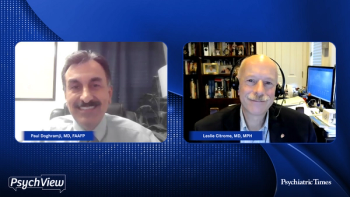
- Psychiatric Times Vol 26 No 11
- Volume 26
- Issue 11
Mental Health Professionals in the “Enhanced” Interrogation Room
On Monday, August 24, 2009, in response to a Freedom of Information Act lawsuit, the Central Intelligence Agency (CIA) released a “Top Secret,” highly redacted May 7, 2004, report, Counterterrorism Detention and Interrogation Activities (September 2001 – October 2003).1 The report’s opening pages concede that the activity it divulges “diverges sharply from previous Agency policy and rules that govern interrogation.”
On Monday, August 24, 2009, in response to a Freedom of Information Act lawsuit, the Central Intelligence Agency (CIA) released a “Top Secret,” highly redacted May 7, 2004, report,
The report outlines “standard interrogation techniques” that “do not incorporate significant physical or psychological pressure,” including “isolation, sleep deprivation not to exceed 72 hours,” and “loud music or white noise.” It also outlines enhanced interrogation techniques (EITs) that “do incorporate physical or psychological pressure,” including attention grasp (slapping), walling (slamming a detainee against a wall), stress positions, sleep deprivation beyond 72 hours, and simulated drowning through “waterboarding.” The report describes this last technique in detail:
[T]he individual is bound securely to an inclined bench. . . . Water is then applied to the cloth in a controlled manner. . . . This effort produces the perception of “suffocation and incipient panic,” ie, the perception of drowning.
In addition, the report documents the use of “Specific Unauthorized” techniques. These include the use of a “handgun and power drill” and “mock execution[s].”
The role of health care professionals
Psychologists participated in every stage of the program’s development and implementation.
Second, those same psychologists sculpted the program’s basic structure. Initially, the CIA retained independent contractor and Air Force psychologist James Mitchell to “research and write a paper on al-Qaeda’s resistance to interrogation techniques.” Then, Mitchell paired with a Department of Defense psychologist and “developed a list of new and more aggressive EITs.”
Third, psychologists crafted individual intake evaluations that assessed mental status and forecast successful techniques. Consider, for example, the psychological profile of al-Qaeda member Abu Zubaydah. The profile observed that his strengths included “ability to focus, goal-directed discipline, intelligence, [and] emotional resilience.” The report predicted interrogation success because Zubaydah “believes [that] the ultimate destiny of Islam is to dominate this world. . . . Thus, there is the chance that he could rationalize that providing information will harm current efforts but represent only a temporary setback.”
Finally, psychologists attended and supervised interrogation sessions. Consider, again, the case of Zubaydah. Federal Bureau of Investigation agent Ali Soufan, who, according to Newsweek, “had a reputation as a shrewd interrogator who could work fluently in both English and Arabic,” conducted the initial interrogation in Guantnamo Bay. Although Soufan’s interrogation was productive, producing information that led to the arrest of Richard Reid, the would-be “shoe bomber,” the CIA brought in Mitchell. Mitchell ratcheted up the interrogation by stripping Zubaydah and barraging him with loud, rock music. When a coffin, apparently for a mock burial, arrived and Soufan objected, the CIA terminated his employment.
Psychologists were not the only health care professionals involved in the interrogations. An April 13, 2005, Army Surgeon General survey revealed that 17% of Afghan and 10% of Iraqi medical personnel had been present during interrogations and that 73% were personally aware of “actual or sus- pected abuse.”
Beginning in January 2004, the government ceased including psychiatrists on the teams. Members of interrogation teams had concluded that “physicians in this role only confused the situation.” Although it is not clear how physicians-presumably the psychiatrists who had been participants in interrogations-confused matters, one incident may provide insight:
One physician was asked to feign evaluations and treatment on detainees by (i) doing a DNA test from a hair sample, (ii) doing a DNA test from a buccal swab, or (iii) providing cough syrup but informing the detainee it was truth serum. The physician complied with the first two requests, but refused to comply with the third. He thereafter refused any further involvement by himself or any of his medical personnel.
The chronology
The road to enhanced interrogation began with a September 25, 2001, memorandum from Deputy Assistant Attorney General John Yoo of the Office of Legal Counsel.7 Yoo asserted that no law “can place any limits on the President’s determinations as to any terrorist threat, the amount of military force to be used in response, or the method, timing, and nature of the response.”
Bolstered by Yoo’s memorandum, on January 18, 2002, President George W. Bush concluded that Geneva Conventions of 1949 would not be applied to al-Qaeda and Taliban detainees. The rationale, provided by Attorney General Alberto Gonzales in a memorandum a few weeks later, was that the Conventions did not apply to “a new paradigm-ushered in not by us, but by terrorists” of armed conflict with groups not associated with any particular country’s government.
In August 2002, Jay Bybee, also of the Office of Legal Counsel, with Yoo’s assistance, authored another memorandum supporting the President’s unfettered power.
In 2003, the White House nominated Bybee to a US Court of Appeals judgeship, and Jack Goldsmith succeeded him as Chief Assistant in the Office of Legal Counsel. Goldsmith immediately withdrew the Yoo/Bybee memos and then resigned. Goldsmith, now on the Harvard Law School faculty, later characterized the memos as “sloppily reasoned, overbroad, and incautious.”
In a 2005 interview with The New Yorker, Yoo, who had returned to the faculty of the University of California, Berkeley, Boalt Hall School of Law, remained unbowed. Congress, he said, cannot “tie the President’s hands in regard to torture. . . . It’s the core of the Commander-in-Chief function.”
In June 2006, the Supreme Court held that detainees are entitled to the protections of the Geneva Conventions. In response, President Bush signed into law the Military Commissions Act, which precluded detainees from invoking those protections. In June 2008, the Supreme Court struck down the law.
Above all, do no harm
The aphorism Primum non nocere is echoed in the Hippocratic Oath’s admonition “to do good or to do no harm” and, since it was first attributed to English physician Thomas Sydenham in 1860, has “remain[ed] a potent reminder that every medical . . . decision carries the potential for harm.”11 That reminder seems to have escaped nearly every health care professional involved in the “War on Terror.” Moreover, whatever the discipline or specialty, participating health care professionals certainly violated the tenets of their professional oaths.
The most broadly applicable is the World Medical Association’s International Code of Medical Ethics prohibition against using “medical knowledge to violate human rights and civil liberties, even under threat.” The AMA Code of Medical Ethics states, “A physician shall be dedicated to providing competent medical care, with compassion and respect for human dignity and rights.” The American Psychiatric Association buttressed this mandate in 2006 with the precept that “no psychiatrist should participate directly in the interrogation of persons held in custody by military or civilian investigative or law enforcement authorities.”
The American Psychological Association (APA), however, has trod a slightly different path. Although its code mandates that “psychologists take reasonable steps to avoid harming their patients or clients,” the organization voted in 2002 that when ethical precepts run afoul of legal rules, “psychologists may adhere to the requirements of the law, regulations, or other governing authority.
In August 2008, the APA membership resolved that psychologists “may not work in settings where persons are held outside of, or in violation of” international or domestic law. Two months ago the APA Council of Representatives voted to direct the APA Ethics Committee to amend the organization’s Ethical Standard 1.02 to reflect the resolution. The council’s directive has been presented to the APA membership for comment. In February 2010, the ethics committee will vote on the measure. Should the committee approve the amendment by a requisite two-thirds vote, the amended standard will go into its ratification by the APA Board of Directors.
Medical personnel involved in interrogations not only forgot the then-existing ethics codes, but they also seemed to have forgotten about the Geneva Conventions, although 94% reported being familiar with their proscriptions against torture. Or, perhaps, they were mindful that the Commander in Chief had concluded that the Conventions were inapplicable to their conduct. If so, then they might have known that his decision also eliminated the protections of Protocol 1: “Under no circumstances shall any person be punished for carrying out medical activities compatible with medical ethics, regardless of the person benefiting therefrom.”
Perhaps this last point is the crux. Health care professionals were in a position to stop what the Administration and its lawyers had promoted, but the promoted position threatened not only the dignity of the detainees, but also the independent professionalism of health care providers.
As the investigation announced by current Attorney General Eric Holder proceeds, maybe we in the legal and health care professions can find reason to hope that the past 8 years will provide incentive for our professional organizations to work together in support of both medical ethics and international human rights laws.
References:
References
1.
Counterterrorism Detention and Interrogation Activities (September 2001-October 2003) (2003-7123-IG), May 7, 2004.
http://www.freedominfo.org/documents/20090824cia.pdf
. Accessed October 9, 2009.
2.
Dept of the Army, Office of the Surgeon General, Final Report, Assessment of Detainee Medical Operations for OEF, GTMO, and OIF (April 13, 2005).
http://www.globalsecurity.org/military/library/report/2005/ detmedopsrpt_13apr2005.pdf
. Accessed October 9, 2009.
3.
Convention Against Torture and Other Cruel, Inhuman or Degrading Treatment or Punishment, Dec. 10, 1984, S. Treaty Doc. No. 100-20, 1465 U.N.T.S. 85.
http://untreaty.un.org/english/treatyevent2001/pdf/ 07e.pdf
. Accessed October 9, 2009.
4.
Dept of Justice. Legal Standard Applicable Under 18 U.S.C. §§ 2340-2340A, December 30, 2004.
http://www.usdoj.gov/olc/18usc23402340a2.htm
. Accessed October 9, 2009.
5.
Isikoff M. We Could Have Done This the Right Way.
Newsweek.
May 4, 2009.
http://www.newsweek.com/id/195089
. Accessed October 9, 2009.
6.
Dept of the Army, Office of the Surgeon General. Final Report Assessment of Detainee Medical Operations for OEF, GTMO, and OIF (April 13, 2005).
http://www.globalsecurity.org/military/library/report/2005/ detmedopsrpt_13apr2005.pdf.
Accessed October 9, 2009.
7.
Memorandum from John Yoo, Deputy Assistant Attorney General, to Timothy E. Flannigan, Deputy Counsel to the President (September 25, 2001). Reprinted in: Greenberg KJ, Dratel JL, eds.
The Torture Papers: The Road to Abu Ghraib.
New York: Cambridge University Press; 2005.
8.
Memorandum from Alberto R. Gonzales, White House General Counsel to President George W. Bush, Re: Decision Re Application of the Geneva Conven- tion on Prisoners of War to the Conflict With Al Qaeda and the Taliban. January 25, 2002.
http://www.humanrightsfirst.com/us_law/etn/gonzales/memos_dir/memo_20020125_Gonz_Bush.pdf
. Accessed October 9, 2009.
9.
Memorandum from Office of the Assistant Attorney General, to Alberto R. Gonzales, Counsel to the President (August 1, 2002).
http://image.guardian.co.uk/sys-files/Guardian/documents/2009/04/16/bybee_ to_rizzo_memo.pdf
. Accessed October 9, 2009.
10.
Mayer MJ. Outsourcing Torture: The Secret History of America’s “Extraordinary Rendition” Program.
New Yorker
. February 14, 2005.
http://www.newyorker.com/archive/2005/02/14/050214fa_fact6#Replay
. Accessed October 9, 2009.
11.
Smith CM. Origin and uses of primum non nocere-above all, do no harm!
J Clin Pharmacol
. 2005; 45:371-377.
12.
American Psychiatric Association. Psychiatric Participation in Interrogation of Detainees: Position Statement. Approved by the Board of Trustees, May 2006.
http://archive.psych.org/edu/other_res/lib_archives/ archives/200601.pdf
. Accessed October 9, 2009.
13.
American Medical Association. Opinion 2.068: Physician Participation in Interrogation.
http://www.ama-assn.org/ama/pub/physician-resources/medical-ethics/code-medical-ethics/opinion2068.shtml
. Accessed October 9, 2009.
14.
American Psychological Association. Ethical Standard 1.02, Conflicts Between Ethics and Law, Regulations, or Other Governing Legal Authority.
http://www.APA.org/ethics/standard-102/provisions-codes.html
. Accessed October 9, 2009.
15.
American Psychological Association. APA Council of Representatives Directs Change in Its Ethics Code to Prevent So-Called Nuremberg Defense. August 5, 2009.
http://www.apa.org/releases/ethical-standard.html
. Accessed October 9, 2009.
Articles in this issue
almost 16 years ago
November 2009 Table of Contentsalmost 16 years ago
Depression During Pregnancyalmost 16 years ago
Living the Questions: Cases in Psychiatric Ethicsalmost 16 years ago
What “Meaningful Use” of Electronic Health Records May Mean to Psychiatristsalmost 16 years ago
Medical Educationalmost 16 years ago
Current Clinical Practice in Asperger Disorderalmost 16 years ago
The Cellular and Molecular Substrates of Anorexia Nervosa, Part 1about 16 years ago
Tarasoff Reduxabout 16 years ago
The Case of Factitious Disorder Versus MalingeringNewsletter
Receive trusted psychiatric news, expert analysis, and clinical insights — subscribe today to support your practice and your patients.














